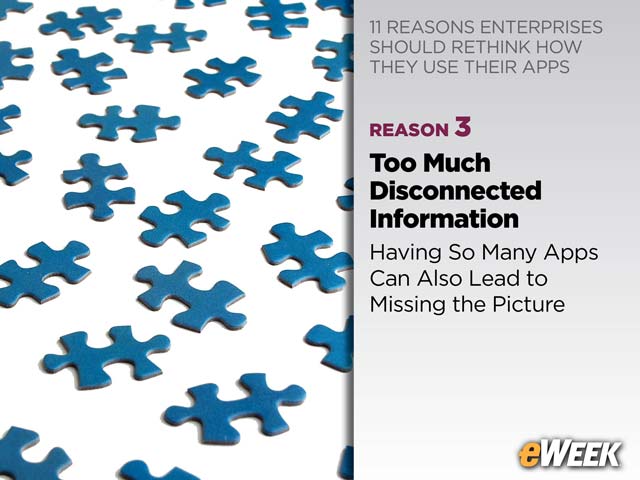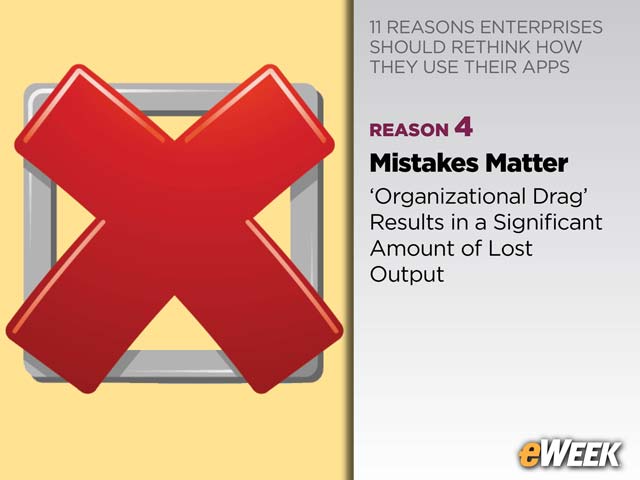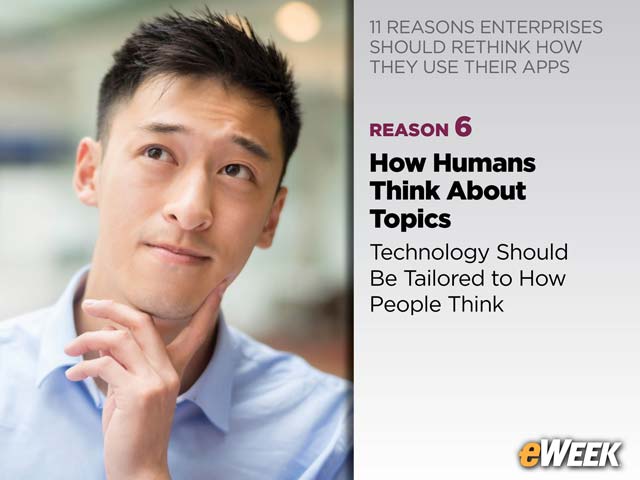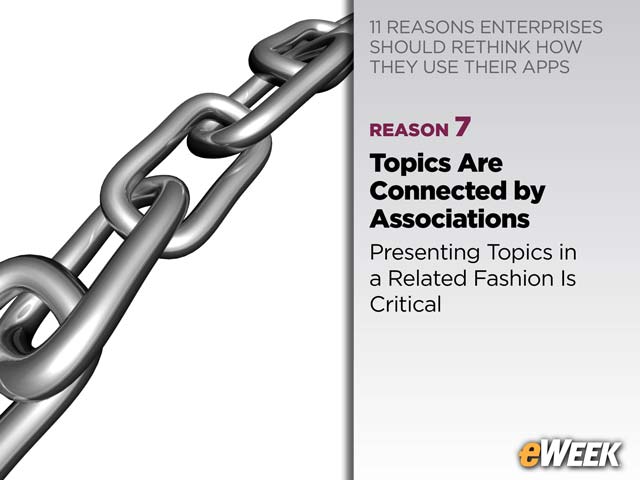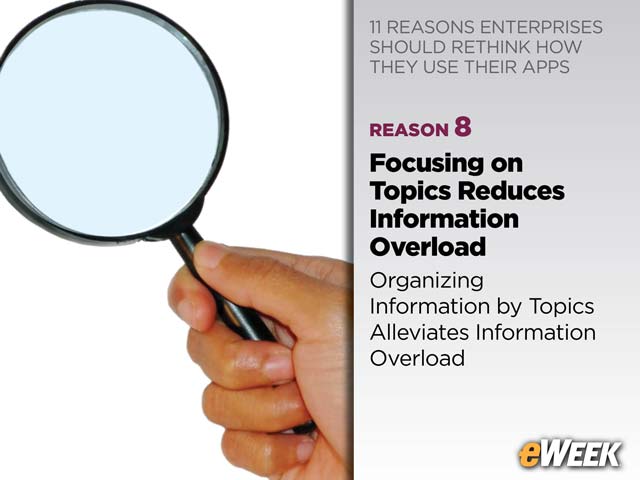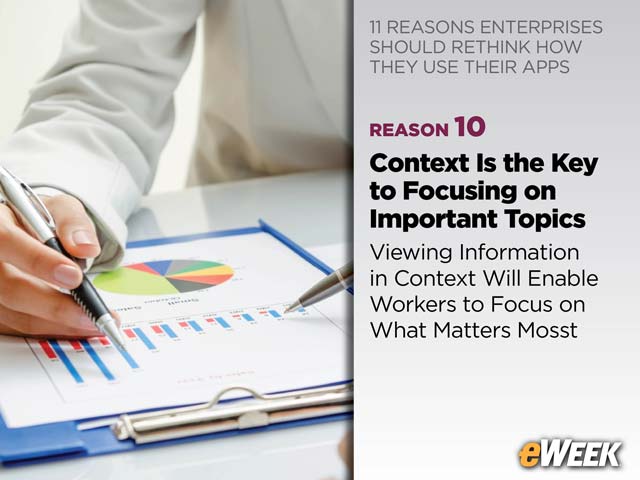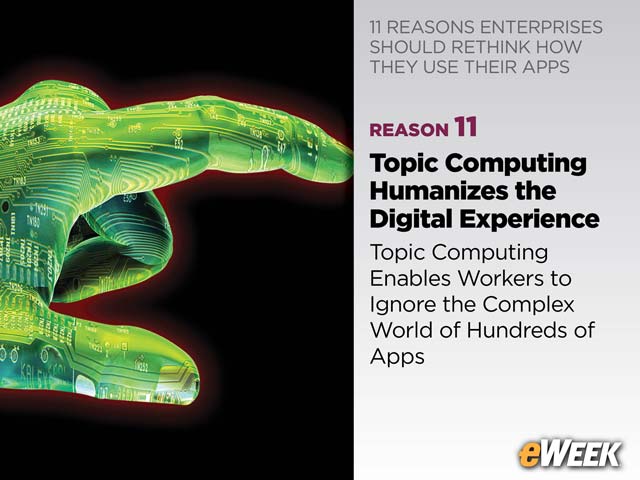eWEEK content and product recommendations are editorially independent. We may make money when you click on links to our partners. Learn More.
111 Reasons Enterprises Should Rethink How They Use Their Apps
Enterprises now use hundreds of cloud services, but the current enterprise app concept is wrong. Why? The human brain simply does not work the way the mess of disjointed cloud services and enterprise apps are designed. Enterprise software conventionally is built around specific processes, but that complicates the digital workplace experience because people naturally think in terms of topics. Our brains are natural organizers; they are wired to put everything in order, creating topical connections between everything to make sense of what we see, hear and experience. Enterprise apps will need to evolve to meet the new world order, which demands usable, consumable data. In this eWEEK slide show, based on industry information from David Lavenda of harmon.ie.
,
we discuss how to rethink the use of enterprise apps.
2The Use of Cloud Apps Is Exploding
The growth of business cloud services is exploding. All you need is a credit card to sign up, and you are good to go. We are living in an “app economy”—as first described by Zuora—where individuals, teams and departments are selecting the cloud apps that best serve their own purposes. This app-happy approach has fueled a surge in enterprise app usage. In fact, the average enterprise has more than 935 business cloud apps, according to Netskope. Thanks to Microsoft’s stronghold in the enterprise, Office 365 is typically viewed as an essential element of the app mix, with an estimated 80 million Office 365 subscribers.
3Too Many Apps
Workers struggle to use all these apps and services effectively. In fact, the more apps we have, the harder it is to be productive. Toggling from one app to another to see the big picture is exhausting and distracting. While one app contains information about a customer account, another one might contain information about the same customer’s service requests. To see the big picture, you need to log in to each app, enter your credentials and navigate to find the information. Multiple user IDs and passwords add to the struggle; remembering one user ID and password is hard enough.
4Too Much Disconnected Information
Most apps are disconnected from one another. The pieces of the enterprise app puzzle rarely fit together. Each one of the 935-plus apps might use a different variation of a customer name or product, and each app has a different set of screens. All of these variations make it even harder and more time consuming for workers to piece together the big picture. This causes people to miss important information and, all too often, drop the ball on important action items.
5Mistakes Matter
Too many apps and too much disconnected information can lead to mistakes and lost productivity. In fact, Bain & Company recently found that the average organization loses more than 20 percent of its productive capacity to “organizational drag”—existing structures and processes that inhibit productivity. This does not just negatively impact productivity, it significantly hurts the bottom line. Harvard Business Review reported that organizational drag results in more than $3 trillion in lost output each year.
6Humans Don’t Think in Terms of Apps
People don’t think about apps, and they shouldn’t have to. They don’t get up in the morning and say, “Hey! What about Salesforce” or “What about Word?” or “What about email?” These are abstractions introduced by technology constraints. Historically, apps have been built in ways that are optimized for processing power, memory storage and bandwidth conservations. Enterprise apps, not people, were built to make the technology more efficient. Today, memory is cheap, bandwidth is freely available, and processing power is a commodity. Workers should no longer be forced to work according to the way technology was designed.
7How Humans Think About Topics
What people do think about is topics. They get up in the morning and ask, “What is happening with my customer?” or “When will the new product be ready?” or “What is the availability of that new service?” Therefore, technology should be tailored to how people think. Technology should be humanized so enterprise information can be delivered the way the brain works. People want to view connected information all at once, regardless of which app the information comes from.
8Topics Are Connected by Associations
It’s been proven that people connect topics by meaningful associations. Topics don’t live in a vacuum. A customer might be connected to a specific product or service because they use that product or service. The fact that these topics are connected has meaning to the person trying to track what is happening with the customer, so presenting the topics in a related fashion is critical for the person to understand what is important for the customer. It’s about making it easy for people to digest the important facts about the topics they care about so they can focus on work, rather than on trying to piece together disconnected bits of information.
9Focusing on Topics Reduces Information Overload
Information overload is brought on by the sheer amount and the (poor) quality of information presented to employees from all their apps. Workers should be able to easily consume information so they can focus on what matters. Organizing and presenting information by topics alleviates information overload. When workers aren’t overloaded, they can be much more productive.
10AI Is the Key to Identifying Topics
How can information be collected from myriad apps and combined in a meaningful way? Each app has a different format for storing information and may use variations of names for things such as customer, product, service or project. This is a daunting task. However, new artificial intelligence technologies in the form of natural language processing and machine learning can solve this complex problem. Extracting topics from text, creating meaningful topics and matching across apps can help humanize enterprise apps. Gartner calls this coherent integration of apps a Unified Workspace, while Forrester includes it in its Cloud Workspaces framework.
11Context Is the Key to Focusing on Important Topics
Presenting information by topics is only part of the story. To complete the vision of topic computing, specific topics need to be displayed only when you are interested in that topic. For example, when you are reading an email about a customer’s project, or if you are reading an RFP document about the same project, you would expect to see all the notifications from all your other apps that relate to the same project—on the same screen as the email or document. When people can view information in context, they truly will be able to focus on what matters to them the most.
12Topic Computing Humanizes the Digital Experience
Information delivered by topics—that’s the way the brain works. This is the crux of topic computing. When people can ignore the complex world of hundreds of apps and focus on their customers, products, projects and services, they can be more productive. Faster hardware, broadband networks, cheap memory and new artificial intelligence technologies are now converging to provide the perfect storm to enable topic computing. We are entering a new age in how people interact with computer technology, and it will forever change the way people work. Because, for the first time, we are at a stage where the limitations of the technology are no longer constraining and a human can be put back at the center of the workplace computing experience.



